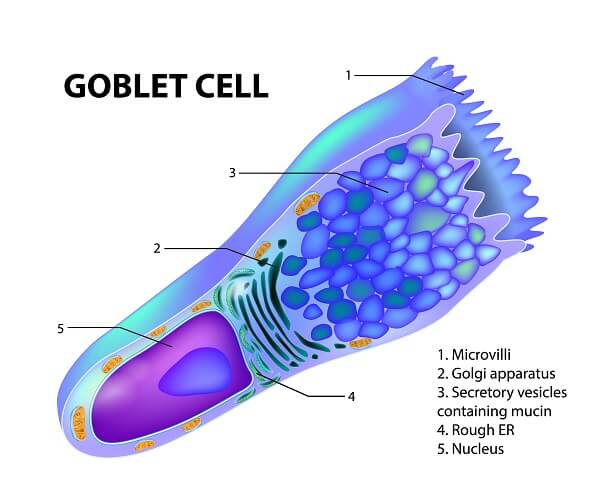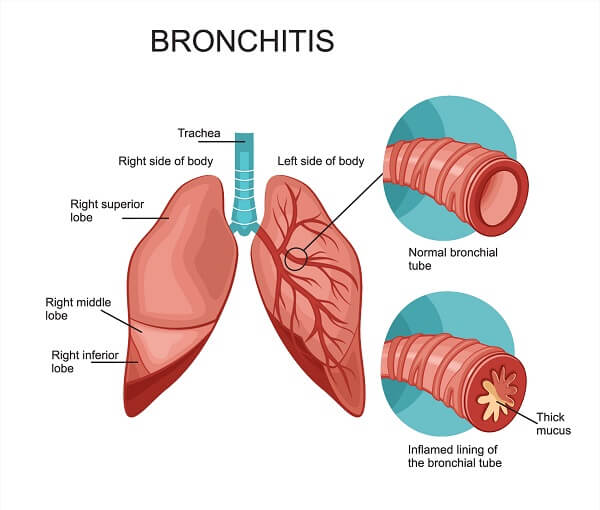Definition
Goblet cells are a specialized type of epithelial cell that secrete mucins, which are significant components of mucus. They are most often found in the respiratory and gastrointestinal tracts, where they make up part of the surface epithelium. The secretion of mucus in these tracts lubricates and protects the lining of the organs. The increased activity or number of goblet cells has been associated with some diseases.

Structure of Goblet Cells
Goblet cells get their name from their cup-like appearance. They are around a quarter as wide as they are tall, and they are polarized, meaning their internal organization is asymmetric.
Their cytoplasmic contents (especially the secretory vesicles) are localized at the apical end of the cell, which is the narrow side, closest to the edge of the tissue. The nucleus and other organelles, such as mitochondria, are located at the basal end, the wider side found towards the base of the tissue.
Goblet cells contain specialized structures that enable them to carry out their function in producing and secreting components of mucus. These features include the extensive and wide-spread endoplasmic reticulum and Golgi apparatus throughout the cytoplasm. These structures are organelles that are crucial for protein production and folding, and modification and transport, respectively.
Additionally, there is an abundance of secretory granules found at the apical side of the cell. These allow it to produce and deliver large amounts of secretions outside into the extracellular space.
Finally, at the apical end of the goblet cell, there are often small projections called microvilli that increase the surface area of the cell. These maximize the space for the cell to secrete its contents into the lumen.
These adaptations are crucial in allowing goblet cells to perform their function of efficiently producing and secreting mucins.

Location of Goblet Cells
Goblet cells are usually found scattered amongst the cells of the simple epithelial tissues that secrete mucus. In some areas, there are a small number of cells, but in others, goblet cells are highly abundant.
Some regions you might expect to find goblet cells are the respiratory (trachea, bronchi, and bronchioles) and gastrointestinal (small intestine and large intestine) tracts. They are also found in the conjunctiva (the membrane of the eye and eyelid), where they are located in stratified epithelium. This is in contrast to their appearance in simple epithelial tissue on the respiratory and gastrointestinal systems.
Function of Goblet Cells
The role of goblet cells is in producing the secretions that form mucus, which lines the surface of some epithelial tissues
Secretion of Mucins
Goblet cells synthesize and secrete proteins called mucins, which are a major part of mucus – a gel-like secretion.
Mucins are highly glycosylated proteins, which means they have many carbohydrate residues attached to their structure. These carbohydrates give mucus its slimy, gel-like consistency. The attachment of these carbohydrate groups occurs in the Golgi apparatus through the actions of enzymes called glycosyltransferases.
From here, the mucins form secretion granules which are transported to the membrane at the apical side of the cell. When required, these granules fuse with the membrane through exocytosis, releasing the mucins outside the cell and into the lumen of the organ.
The main mucin proteins secreted by goblet cells in the respiratory tract are called MUC5AC and MUC5B. In the respiratory tract, they more often secrete another mucin protein, MUC2.

Mucus
Mucins are a component of mucus, which is a viscous fluid that is primarily composed of mucins, water, and inorganic salts. It lubricates the linings of the tissue from which it is released, and protects the surface from harmful particles and the external environment.
- Respiratory system – goblet cells are particularly important in the respiratory tract. They are often found in the trachea, bronchi, and bronchioles – where mucus is essential for trapping and protecting the delicate alveolar tissue of the lungs from foreign particles that could damage them. These particles include dust and allergens, as well as potential pathogens such as bacteria.
- Digestive system – mucus is important throughout the gastrointestinal tract for lubricating the surfaces of the tissues that materials must slide down. For example, food sliding down the esophagus and protecting the lining of the stomach from the acidic environment. Goblet cells are primarily involved in mucus production in the lower intestine, rather than in the stomach.
- Reproductive system – cervical mucus is also produced in the reproductive tract, but this does not usually involve goblet cells. Instead, other cell types secrete cervical mucus.
Clinical Relevance
Goblet cells are implicated in a few diseases either due to their increased activity (hyperproduction of mucus), increased number, or aberrant presence at new sites.
Increased Secretion of Mucin
Increased production of mucus is associated with asthma and chronic bronchitis. Asthma is an allergic condition associated with airway inflammation. Part of the pathophysiology of asthma includes an increase in the number of goblet cells in the airways, termed hyperplasia. Hyperplasia leads to increased production of mucus and worsening of the symptoms of asthma.
Chronic bronchitis is another condition associated with goblet cell hyperplasia and increased mucus production. It is linked with irritation in the bronchioles, causing the build-up of mucus in the lungs. This irritation of the epithelium is usually caused by smoking, which stimulates mucin production.

Goblet Cell Metaplasia
Goblet cell metaplasia describes instances where goblet cells are found at locations they are generally not expected to be. It is often referred to as intestinal metaplasia because goblet cells are often considered intestinal cells (as this is one of the locations they are primarily found). Such aberrant cells are identified through a process called histology, where tissue structure and cell composition are examined under a microscope.
This metaplasia can occur in a disorder called Barret’s esophagus, which is characterized by the presence of goblet cells in the esophagus. Barret’s esophagus is an inflammatory condition caused by long-term acid reflux. This constant reflux damages the esophagus, causing the tissue to contain abnormal cell types such as goblet cells.
Goblet cell metaplasia can also occur in various cancers of the female reproductive tract, including endocervical adenocarcinomas, as well as non-cancerous lesions of the cervix.
Goblet Cell Carcinoid
A goblet cell carcinoid is a rare cancer that is almost always found in the appendix, and occasionally in the gastrointestinal tract. These tumors are a type of neuroendocrine tumor, which is a tumor arising from cells that produce hormones, while also displaying features of a more aggressive type of tumor called an adenocarcinoma. They are most common in individuals over fifty years of age and generally have a good prognosis, with over 75% of people surviving five years after diagnosis.
Quiz
